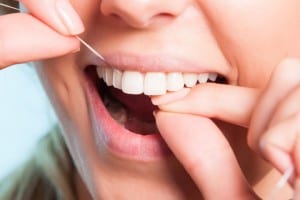Why is it so important to have proper Oral Hygiene?
Gum disease makes adults 35 years or older lose more teeth than cavities do. Three adults out of four have this problem during their lives at some point. The ideal method for preventing dental issues such as cavities, gum disease, and other oral problems is through practicing proper daily oral hygiene such as flossing and brushing.

Bacterial plaque is the cause for cavities / gum disease, and other oral health issues. The colorless film of plaque accumulates on your teeth next to your gums. This forms on the teeth during the day and night. You can remove this easily just by flossing and brushing at least twice a day. This prevents the buildup of germs that could lead to gum disease.
Proper Brushing Technique

Call the office immediately at (707) 800-3556 if you experience pain during brushing your teeth or have any questions. Dr. Frey also advises you to use only a soft of ultrasoft bristle toothbrush when brushing your teeth. Hold the brush on your teeth on each side of your mouth where they meet the gums at a 45-degree angle. Brush gently using a circular motion with small, light strokes on the outside surface of each tooth. Apply gentle pressure when placing the brush in between your teeth, as too much pressure could cause pain or gum recession. Repeat this motion on the back of the teeth once you finish the outside surfaces of them with the same directions to clean those areas gently.
Hold the brush vertically, though, when brushing the lower and upper front teeth. Make numerous strokes in a back-and-forth direction gently over each one of the front teeth. You need to make sure to remember also to brush gently the gum tissue surrounding the teeth.
You clean the bite-surface area of the teeth after you finish the other parts of the teeth using gentle, short strokes. Move the brush to different angles as needed to clean and reach all the areas of the teeth. Look in the mirror while brushing to make sure you clean all the surfaces of each tooth. When you finish brushing, rinse thoroughly with water to rinse away any loose plaque.
The Correct Way to Floss Your Teeth

Gum disease typically occurs in the spaces between your teeth that the toothbrush has a hard time reaching. Flossing enables you to remove the plaque from these spaces effectively. However, you must do it in the right manner. Follow the instructions below, and remember you will need some practice and time to get them right.
Take a piece of floss that is about 18 inches in length. Wrap one end of this floss around your right middle finger and the other end of the floss around your left middle finger.
Tightly grasp the floss with your forefinger and thumb on each hand to floss your upper teeth. Insert your floss gently tight against your teeth and use a sawing motion to remove the plaque and food debris. Be careful not to snap or force the floss into place. Guide the floss down to the gums and gently curve it around each tooth in the process. Slide the floss up just enough to feel a slight resistance. Shift the floss vertically back and forth on the side of each tooth. Make sure to get both sides of every tooth. Finish all the upper teeth first before going on to the lower teeth. Remember to be gentle so you do not cut into the gums. Refresh the floss, as it becomes soiled by doing another wrap around your fingers. Repeat the above directions for your bottom teeth just down to the gums instead of up to the gums. Also, remember to do the back of both upper and lower back teeth.
Remember to rinse your mouth thoroughly with water to make sure all the food and loosened plaque is rinsed down the drain. Do not worry if your gums become sore or bleed during the first week of flossing regularly, as this is normal. When your gums hurt during flossing, you may be pressing too hard into the gums. Your gums will heal as you work into a regular routine of flossing and the bleeding should quit.
Taking Care of Sensitive Teeth
Teeth are at times sensitive to both cold and hot after a dental hygiene treatment. This will not last that long if you keep your mouth clean. However, with improper hygiene the mouth could even become more sensitive to cold and hot items. Consult with a dentist when oral sensitivity becomes problematic for you. He might advise you to use a medicinal mouth rinse or toothpaste made to help sensitive teeth be less sensitive.
Selecting Products for Oral Hygiene
It is confusing to try to select from the numerous products for taking care of your teeth and mouth on the market today. Check out some suggestions below for selecting products for dental care that work effectively for many people to help clear some of the confusion.
Electronic, vibrating toothbrushes are effective and safe for most people to use. Some of these toothbrushes will contain a rubber tip on their handles to use for massaging the gums after the when the users are finished brushing their teeth. There are those that also contain tiny brushes for reaching in between the teeth. Be careful using these, though, as you do not want to injure your gums. Two brands of the high-tech toothbrushes that are highly effective are Sonicare and Oral-B.
Oral irrigators shoot water into the mouth and around the teeth to rinse them thoroughly, but this device does not loosen plaque. You have to floss, brush, and use the irrigator for the best results.
In addition to using high-tech products, there are toothpastes and mouth rinses that contain fluoride. These are highly effective when used in conjunction with flossing and brushing as they reduce tooth decay by up to 40%. Make a note, though, that most mouthwashes are not recommended for kids younger than six years old. Tartar control toothpastes have the ability to lower the accumulation of tartar on the teeth, but remember that gum disease happens below the gum line. This means these toothpastes do not yet help lower the risk of gum disease.
The American Dental Association approves anti-plaques rinses that contain ingredients that could aid in bringing the early stages of gum disease under control. These still have to be used in conjunction with flossing and brushing.
Professional Dental Cleaning
Flossing and brushing daily minimizes the amount of dental tartar build-up. It takes a profession cleaning to remove the dental tartar that flossing and brushing leave behind. You dental visit is a crucial step in preventing gum disease. Only you can take the proper oral hygiene measures to make sure you teeth stay with for the rest of your life.




